Patent Applicant Pendency in Various Countries: Part 1
As clients begin to develop global patent portfolios, an effective practitioner will be aware of basic information related to application filing and pendency in locales where protection is sought. This article provides a high-level look at application pendency, grant rates, and effects of lapse in select countries in South America.
Filing, Examination, and Fees
This is Part 1 in an anticipated four-part series on patent application pendency, grant rates, and effects of lapse in select countries. Part 1 focuses on Venezuela, Argentina, Brazil, Columbia, and Ecuador. Patent Applicants and Practitioners are advised to contact local counsel with any specific questions not covered in this article.[1]
Many clients that have complex intellectual property portfolios often have patents and applications in a dozen or more countries around the world. Effective intellectual property management requires understanding of the client’s goals as well as the differences in rules and procedure in various patent examining jurisdictions, and what patent life, if any, may be expected in return for monetary investment in a given patent examining jurisdiction. One aspect of global intellectual property management is an understanding of application pendency, grant rates, and effects of lapse in countries where the client desires protection.
This series of articles is meant to aid Applicants in deciding where to spend resources to obtain patent coverage by provide information regarding 1) substantive examination, 2) the length of time expected between filing and the first action from the patent office, 3) the length of patent term, 4) potential consequences of allowing an application to go abandoned should the applicant not want to pay the grant fees or annuities[2], and 5) the current state of the patent examination process. The information is presented on a country-by-country basis.
Bolivarian Republic of Venezuela
Venezuela is a party to the Paris Convention, but not a party to the Patent Cooperation Treaty. Accordingly, patent applications filed in Venezuela must be filed within 12 months of the foreign priority application.
Over the last decade, Venezuela has seen the number of applications filed by non-residents drop year over year.[3]
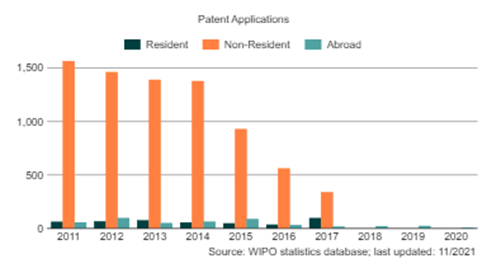
Similarly, the number of patents being granted in Venezuela over the last decade has been essentially zero with no patents being in force from 2011 to 2020.[4]
Venezuela recognizes Utility Patents and Industrial Designs. For Utility Patents and Industrial Designs having a grant date before October 1, 2020, the grant is valid for 10 years from the application filing date. For Utility Patents having a grant date after October 1, 2020, the grant is valid for 20 years from the registration date. For Industrial Designs having a grant date after October 1, 2020, the grant is valid for 10 years from the registration date.
Annuities in Venezuela are due according to when the application granted. For Utility Patents and Industrial Designs having a grant date before October 1, 2020, the first annuity is paid when the application is filed. Once granted, the grant fees and accumulated annuities for the second year until the year of grant are due when the application is granted in the Official Bulletin. Maintenance fees for these patents are paid on the last day of the filing anniversary month.
For Utility Patents and Industrial Designs having a grant date after October 1, 2020, the first annuity is similarly paid when the application is filed. The second annuity is due concurrently with the grant fees. Maintenance fees for these patents are paid on the anniversary of the registration date.
In Venezuela, other than loss of patent rights, there are no negative implications for allowing an application to lapse. This is the case whether the application lapses during examination, or if the grant fees and accumulated or second-year annuities are not paid.
Finally, patent examination in Venezuela has recently been extremely slow with some backlogs exceeding 10 years. In an apparent effort to reduce the backlog, the Venezuelan Trademark and Patent Office has changed the criteria for examination and begun granting patents again over the last two years. The 20-year term from the date of registration (10-year term for Industrial Designs) has been implemented by the Venezuelan Trademark and Patent Office in consideration of the historically substantial backlog.
Argentine Republic
Argentina is a party to the Paris Convention, but not a party to the Patent Cooperation Treaty. Accordingly, patent applications filed in Argentina must be filed within 12 months of the foreign priority application.
Over the last decade, Argentina has seen the number of applications filed by non-residents drop slightly around 2015, but otherwise remained relatively stable.[5]
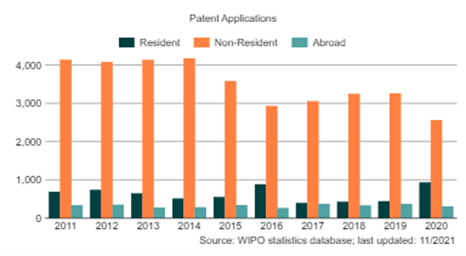
Over this same time period, the number of patents being granted in Argentina has generally trended upward.[6]
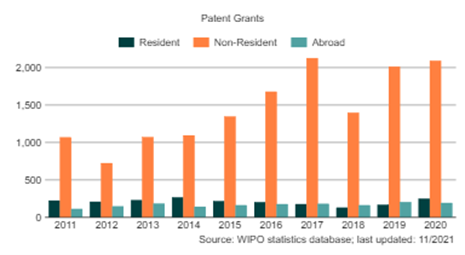
Argentina recognizes Utility Patents and Industrial Designs. A request for examination is compulsory in Argentina to avoid abandonment and must be requested at the time of filing the application, or within 18 months from the local filing date. Utility Patents are given a patent term of 20 years from the date of filing in Argentina. Industrial Designs do not undergo substantive examination and only undergo formal examination. Industrial Designs are given a patent term of 5 years from the date of grant, which is renewable for up to two additional consecutive 5-year terms.
Annuities in Argentina are due according to when the application granted. For Utility Patents, the accumulated annuities—starting with the third annuity—are paid when the application is granted. Annuities are due each year thereafter if the patent is to remain in force. For Industrial Designs, the renewal fees are due within 6 months prior to the current term expiration.
In Argentina, other than loss of patent rights, there are no negative implications for allowing an application to lapse, such as debt owed by the Patent Owner. This is the case whether the application lapses during examination, or if the grant fees and accumulated annuities are not paid. There is no process to revive an abandoned application in Argentina once an abandonment resolution has been issued.
Finally, patent examination in Argentina has been slightly slower than examination in other countries, with some backlogs exceeding 5 years. An Applicant can expect a delay of between 3 and 5 years from the date of filing to the date of first action, depending on the technology. The Argentina PTO is trying to improve examination procedures towards speedier examination. Applications examined under AR PTO Res. 56/2016—a type of Patent Prosecution Highway program—have been resolved much faster than those filed under ordinary examination.
Federative Republic of Brazil
Brazil is a party to the Paris Convention and to the Patent Cooperation Treaty. Accordingly, patent applications filed in Brazil must be filed within 12 months of the foreign priority document through provisions of the Paris Convention, or 30 months of the foreign priority application through provisions of the Patent Cooperation Treaty, provided that a PCT application has been filed.
Over the last decade, Brazil has seen the number of applications filed by non-residents drop slightly around 2016, but otherwise remained relatively stable.[7]
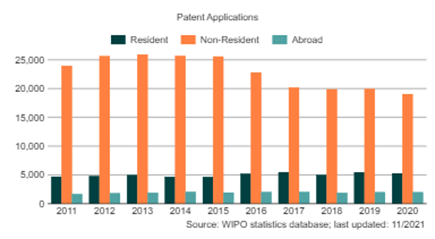
Over this same time period, the number of patents being granted in Brazil has trended significantly upward.[8]
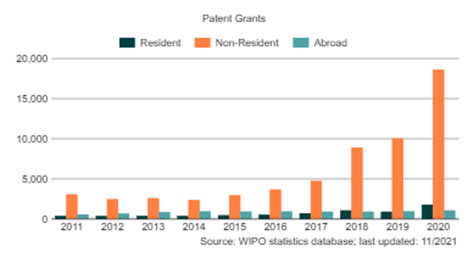
Brazil recognizes Invention Patents, Utility Model Patents, and Industrial Designs. A request for examination is compulsory in Brazil to avoid abandonment and must be requested at the time of filing the application, or within 36 months from local filing date. Invention Patents are given a patent term of 20 years from the date of filing in Brazil. Utility Model Patents are given a patent term of 15 years from the date of filing in Brazil. Industrial Designs are given a patent term of 10 years from the date of grant, which is renewable for up to three additional consecutive 5-year terms.
Annuities in Brazil are due starting with the 3rd year from filing date. Annuities are due each year thereafter if the patent is to remain pending or in force.
In Brazil, other than loss of patent rights, there are no negative implications for allowing an application to lapse. This is the case whether the application lapses during examination, or if the grant fees and accumulated annuities are not paid.
Finally, patent examination in Brazil, prior to 2018 has been very slow with some backlogs exceeding 8 years. In 2018, the Brazil PTO implemented procedures to reduce the backlog and issue patents more quickly. One of these initiatives is the issuances of a “Preliminary Office Action” which requests the Applicant to amend the claims to those as issued in another examining jurisdiction where the prior art references have been cited, with preference being given to EP and US. These Preliminary Office Actions are issued automatically around the 12-month mark from the date of Requesting Examination.
Following the filing of a response to the Preliminary Office Action, an Applicant can expect a delay of 1.5 years or more, depending on technology area, before technical examination continues. However, due in part to the adoption of the Preliminary Office Action procedure, and other expedited examination programs, allowance decisions have increased within the past few years, with this trend likely to continue.
Republic of Columbia
Columbia is a party to the Paris Convention and to the Patent Cooperation Treaty. Accordingly, patent applications filed in Columbia must be filed within 12 months of the foreign priority document through provisions of the Paris Convention, or 30 months of the foreign priority application through provisions of the Patent Cooperation Treaty, provided that a PCT application has been filed.
Over the last decade, Columbia has seen the number of applications filed by non-residents remain relatively stable.[9]
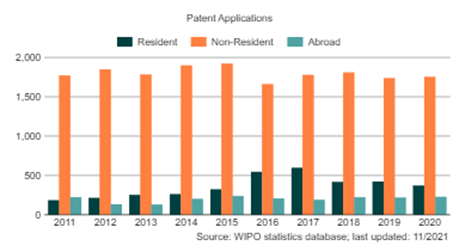
Over this same time period, the number of patents being granted in Columbia has trended downward.[10]
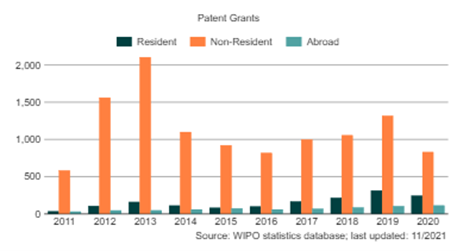
Columbia recognizes Utility Patents and Industrial Designs. A request for examination is compulsory in Columbia to avoid abandonment. In Columbia, the patent application is normally published within a month from the date of filing. The request for examination must be filed within 6 months from the date of publication. Utility Patents are given a patent term of 20 years from the earliest priority date. Industrial Designs are given a non-renewable patent term of 10 years from the date of filing.
Annuities in Columbia do not accumulate and are due according to when the application granted. The first annuity is due before the last day of the month in which the application was filed, starting in the year the patent is issued. Annuities are due each year thereafter if the patent is to remain in force.
In Columbia, other than loss of patent rights, there are no negative implications for allowing an application to lapse. This is the case whether the application lapses during examination, or if the grant fees and accumulated annuities are not paid.
Finally, an Applicant can expect a delay of 1.5 to 2 years or more, depending on the technology area, between requesting examination and the issuance of a first action.
Ecuador
Ecuador is a party to the Paris Convention and to the Patent Cooperation Treaty. Accordingly, patent applications filed in Ecuador must be filed within 12 months of the foreign priority document through provisions of the Paris Convention, or 30 months of the foreign priority application through provisions of the Patent Cooperation Treaty, provided that a PCT application has been filed.
Since 2013, Ecuador has seen the number of applications filed by non-residents remain relatively stable.[11]
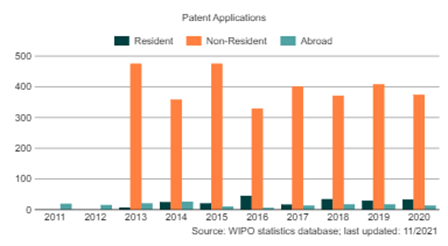
Over this same time period, with 2014 being an exception, the number of patents being granted in Ecuador has remained relatively stable.[12]
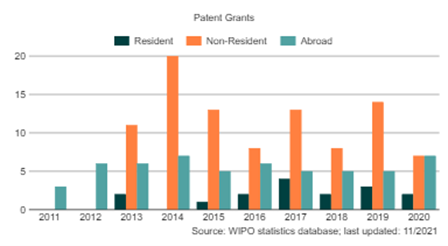
Ecuador recognizes Utility Patents and Industrial Designs. A request for examination is compulsory in Ecuador to avoid abandonment. The request for examination must be filed within 6 months from the date of publication. Utility Patents are given a patent term of 20 years from the date of filing. Industrial Designs are given a non-renewable patent term of 10 years from the date of filing.
Annuities in Ecuador do not accumulate and are due in advance for each year in the month in which the anniversary of the filing date occurs. Annuities are due each year thereafter if the application, and subsequent patent, is to remain in force.
In Ecuador, other than loss of patent rights, there are no negative implications for allowing an application to lapse. This is the case whether the application lapses during examination, or if the grant fees and accumulated annuities are not paid.
Finally, the Ecuadorian PTO has a high backlog of cases beginning from the year 2012. The PTO is in a negotiation phase for the Patent Prosecution Highway (PPH) agreement with the USPTO and the PTO offices in Peru and Chile. Currently, an Applicant can expect a delay of 3 years or more depending on the technology area, between requesting examination and the issuance of a first action.
Part 2 of this series will focus on select countries in Africa. Part 3 of this series will focus on select Gulf States. Part 4 of this series will focus on select countries in South East Asia and Oceana.
[1] Special thanks to our friends and colleagues at Simões IP, ClarkeModet, and Pérez Bustamante & Ponce for answering our questions during the preparation of this article.
[2] In some jurisdictions over the years, fees due, but not paid, were treated as a debt owed by the Patent Owner. To avoid the debt, the Patent Owner was required to expressly disclaim or abandon the patent.
[3] WIPO IP Statistics, https://www.wipo.int/ipstats/en/statistics/country_profile/profile.jsp?code=VE
[4] Id.
[5] WIPO IP Statistics, https://www.wipo.int/ipstats/en/statistics/country_profile/profile.jsp?code=AR
[6] Id.
[7] WIPO IP Statistics, https://www.wipo.int/ipstats/en/statistics/country_profile/profile.jsp?code=BR
[8] Id.
[9] WIPO IP Statistics, https://www.wipo.int/ipstats/en/statistics/country_profile/profile.jsp?code=CO
[10] Id.
[11] WIPO IP Statistics, https://www.wipo.int/ipstats/en/statistics/country_profile/profile.jsp?code=EC
[12] Id.




